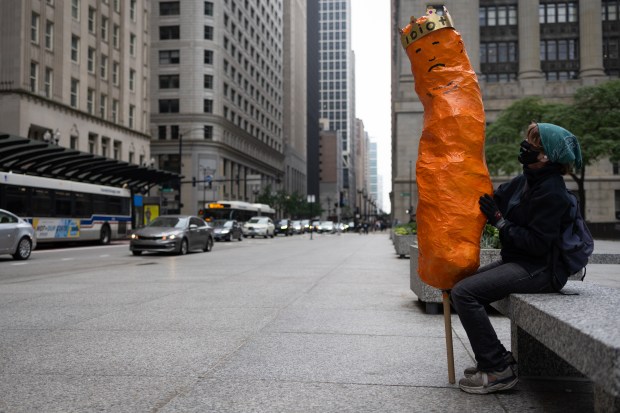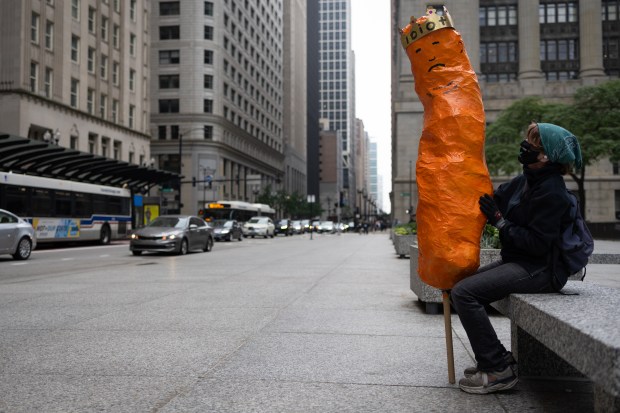Aldermen took aim Monday at two sacred cows of policing in Chicago: How officers are deployed around the city and when they have to leave their jobs.
The City Council’s Committee on Police and Fire voted to require the Chicago Police Department to conduct a citywide staffing analysis. The ordinance could lead to a push for widespread changes to where and when police are deployed if passed by the full City Council.
Such debates can get heated, as certain areas of the city stand to lose patrol officers while others gain them.
Aldermen also considered raising the age at which police and firefighters are required to retire from 63 to 65, an effort that would give department veterans the opportunity to keep working longer.
Concerns about police staffing levels hovered over the back-to-back discussions. The effort to fill longstanding vacancies in hundreds of police jobs has left Chicago with a department that has gotten “very young, very quickly,” Chief of Constitutional Policing and Reform Angel Novalez told aldermen.
The Police Department is backing the mandatory retirement age change in a bid to retain older cops, Novalez said.
“We lose those informal leaders and that institutional knowledge walks out the door with retirement,” he said.
The department’s effort to recover from a sharp 2021 decline in its sworn workforce prompted it last spring to try to win back retirees and officers in other jurisdictions with sweeteners like salary credit for time served elsewhere and lowered exam requirements. Police leaders have also doled out overtime pay and canceled holidays, costly moves that have led to officer burnout and hurt morale.
The number of sworn CPD members has held nearly steady for two years, with a roughly 100-person increase to 11,780 members since Mayor Brandon Johnson took office in June.
Johnson’s first budget eliminated more than 800 of the around 1,440 vacant street cop positions and created almost 400 new civilian positions, which his administration touted as a way to free up more officers to patrol. His administration also agreed in October to a contract with the union representing rank-and-file police officers that would provide a roughly 20% raise to officers over four years.
Chicago Fraternal Order of Police President John Catanzara predicted before the 2023 mayoral runoff that as many as 1,000 officers would leave if Johnson won, an estimate that has so far proven wrong.
At Monday’s committee meeting, Catanzara threw the police union’s support behind the mandatory retirement age change. Many officers “go out the door clawing and scratching” when they are forced to retire at 63 now, he said.
“They do not want to leave,” Catanzara said. “If they have the opportunity to stay, many of them will take that opportunity.”
If more officers who can retire stay on the force, more workers will be paying into the police pension fund and fewer pensioners will be cashing out, he said.
While the police department and the rank-and-file police union support the change, the proposal drew criticism from Chicago Fire Department leaders. The tweak would amount to “aging the department,” a tough sell for an “intensely demanding pursuit” that would also leave younger firefighters less likely to get promotions, CFD Chief of Special Operations Jamar L. Sullivan said.
“Before we just decide, I think we should take a look and make sure that it is the absolute best force,” Sullivan said.
While most aldermen spoke in support of the change, Ald. Nick Sposato, 38th, argued it was a “terrible idea” for the fire department.
“It’s a young man’s job,” said Sposato, himself a Fire Department veteran. “You got to be ready to go.”
The committee will vote on the proposal in coming months after more hearings, committee chair and ordinance sponsor Ald. Chris Taliaferro, 29th, said.
The committee also voted Monday to put up for a City Council vote an ordinance that would require a sweeping study of how police are deployed across Chicago.
If passed, the ordinance would compel the Police Department and partners to use data to design a strategy for the politically thorny question of where and when officers should be deployed.
The ordinance says the study shall use “a data-driven allocation methodology … that shall be used moving forward to adjust department staffing,” though similar studies have not led to changes in the way officers are deployed.
The University of Chicago Crime Lab completed a similar analysis in 2021 that showed deployment levels decline during the weekend overnight time periods when shootings are going up.
However, a year later, Police Superintendent David Brown called the study lacking. He announced plans to seek his own officer deployment evaluation – plans that never came together before he left his post in March 2023.
“Members of the public and our body deserve more transparency around how staffing decisions are made,” sponsor Ald. Matt Martin, 47th, said as he introduced the ordinance Monday.
Police Superintendent Larry Snelling made news recently when he announced he would suspend a deployment initiative in which officers are assigned to sit in their cars downtown in high-visibility areas as a crime-deterrent.
The study would be completed by a third party group within a year and would cost around $1 million, Martin said. Philanthropic groups have already offered to pay the bill, he added.
Through better scheduling and officer placement, the study could help reduce police response time and the canceled days of that have long-plagued officers, Martin said.
“We’re required to do this by the consent decree, we’ve been talking about it for many years in fits and starts. I believe now is the time to get it done,” he said.
Ald. Jason Ervin, 28th, said he supports the effort to reconsider police deployment, but thinks there must first be clearer metrics for how consultants will determine where police are needed. The University of Chicago’s 2021 study considered metrics like the location and time of shootings, GPS information from police vehicles and response times.
“We as a body need to set some standards,” Ervin said. “Walking into this, we have to have some objective points that we have laid out.”
Each of the department’s 22 districts currently has between 239 and 371 officers assigned to patrol, according to data made available by the Office of Inspector General.
The most violent and most populated districts — Harrison (11th) and Near North (18th), respectively — have the most cops on patrol. Meanwhile, the two most quiet districts — Jefferson Park (16th) and Lincoln (20th) — have the fewest.
The work force allocation ordinance passed unopposed in a voice vote, though Sposato and Ald. Silvana Tabares, 23rd, later asked to be recorded as “no” votes.
Tribune reporter Sam Charles contributed to this article




